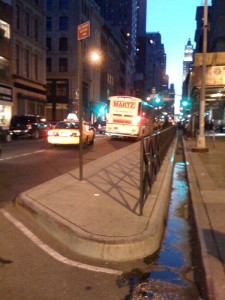Dim Bulbs
 When the “bus bulbs”—occasional extensions to the sidewalk along Broadway, in Soho and Tribeca, where bus passengers can wait—were added in 2007, the Department of Transportation claimed that they would actually aid the flow of vehicles on Broadway because buses wouldn’t have to pull in and out of traffic. The head of Transportation Alternatives, which backed the plan, said that the bus bulbs had worked in cities such as San Francisco, Seattle, and Portland, Ore. (That’s the same logic that pushed parked cars into the middle of Grand Street, giving precedence to a bike lane even though hardly anyone bikes there and making crossing the street rather hazardous. New York doesn’t have a bike-friendly West Coast climate and never will.)
When the “bus bulbs”—occasional extensions to the sidewalk along Broadway, in Soho and Tribeca, where bus passengers can wait—were added in 2007, the Department of Transportation claimed that they would actually aid the flow of vehicles on Broadway because buses wouldn’t have to pull in and out of traffic. The head of Transportation Alternatives, which backed the plan, said that the bus bulbs had worked in cities such as San Francisco, Seattle, and Portland, Ore. (That’s the same logic that pushed parked cars into the middle of Grand Street, giving precedence to a bike lane even though hardly anyone bikes there and making crossing the street rather hazardous. New York doesn’t have a bike-friendly West Coast climate and never will.)
What the bus bulbs do is constrict Broadway, which is already a mess along the blocks north of Canal. The bus bulbs take up one lane; any bus stopping there—and they’re tour buses, more often that not—takes up another. If anyone else on the block double-parks—and this being New York, double-parking is a constant—the traffic flow goes down to one lane. Broadway comes to a virtual standstill, and gridlock, honking, and poor air quality ensue.
As a result, there’s no easy way to get downtown by car: Varick gets clogged up because of the Holland Tunnel, Broadway is now having a perpetual stroke, Bowery dead-ends at the closed Park Row (though cars can traverse along Worth), and the chaos at the Brooklyn Bridge exit makes taking the FDR a disaster (you have to go all the way around the southern tip of Manhattan and back up West Street).
The DOT’s thinking seems to come from a time when fewer people lived in Lower Manhattan; over the past few years, however, many massive residential projects have sprouted up—88 Leonard, Barclay Tower, the upcoming Beekman Tower. I’d love to live in a city where no one drove at all, but that’s just not likely to happen anytime soon; we can’t all bike to and from work.
I don’t have an objection to testing new initiatives; good results will sometimes happen. The important thing is to know when an initiative has failed—and anyone taking even a cursory look at the bus bulbs can see that they have failed. It’s time for them to go.













I find it hard to take your criticism of bus bulbs and the Grand St. bike lane seriously. From what I can see, you just kinda, sorta noticed that things seem more crowded and Broadway now and that “hardly anyone” bikes on Grand St. Forgive me if I don’t give your top-of-the-head observations much credence. If you’re going to spout off, how about finding some facts or numbers to back up your talk. Broadway between Houston and Canal was a mess before the bulbs, and a mess now. You don’t make much of a case that it’s worse now and the bulbs should be deemed a failure – except that, gee, it kinda, sorta seems worse to you. I also find it strange that someone so worried about car traffic and air quality is so down on bike lanes. Again, your observation isn’t backed up by anything solid. In five minutes of looking I found a report about the Grand St. bike lane on the WNYC Web page from October that said that since the lane was installed in November 2008, “The number of injuries to cyclists, pedestrians and motorists has dropped from about three a month to about two. Overall accidents, including fender benders, declined 16 percent.” Those numbers are from the DOT, which also claimed bike ridership on Grand St. had increased 60 percent over the previous 18 months. Another report I found claimed the DOT said it counted 990 bike riders using the Grand St. path in one 12-hour period last July. That’s a far cry from “hardly anyone.”
I’m not trying to say that the Broadway bus bulbs should stay, nor that the Grand St. bike lane is an unequivocal positive. I’m saying that if you want anyone to take what you have to say seriously, do a little reporting to back up your statements. Otherwise, it’s just propaganda.
You’re right that it was an opinion, of course, although in fairness I never tried to pass it off as anything else. I figured that the post might get a conversation started—which I suppose it has, even if the response wasn’t exactly what I hoped to hear. (I do, however, take issue with the notion that I “just kinda, sorta” noticed how disruptive the bus bulbs are. I’ve been watching their effects with dismay since they first appeared, and I trust my own eyes more than DOT statistics, if they exist on this topic.)
I’m not an expert on much of what I cover, but if I limit myself to those subjects there won’t be much here to read. Ideally, someone with more knowledge of these issues would contribute—and if you’re ever interested in writing, I hope you’ll get in touch.